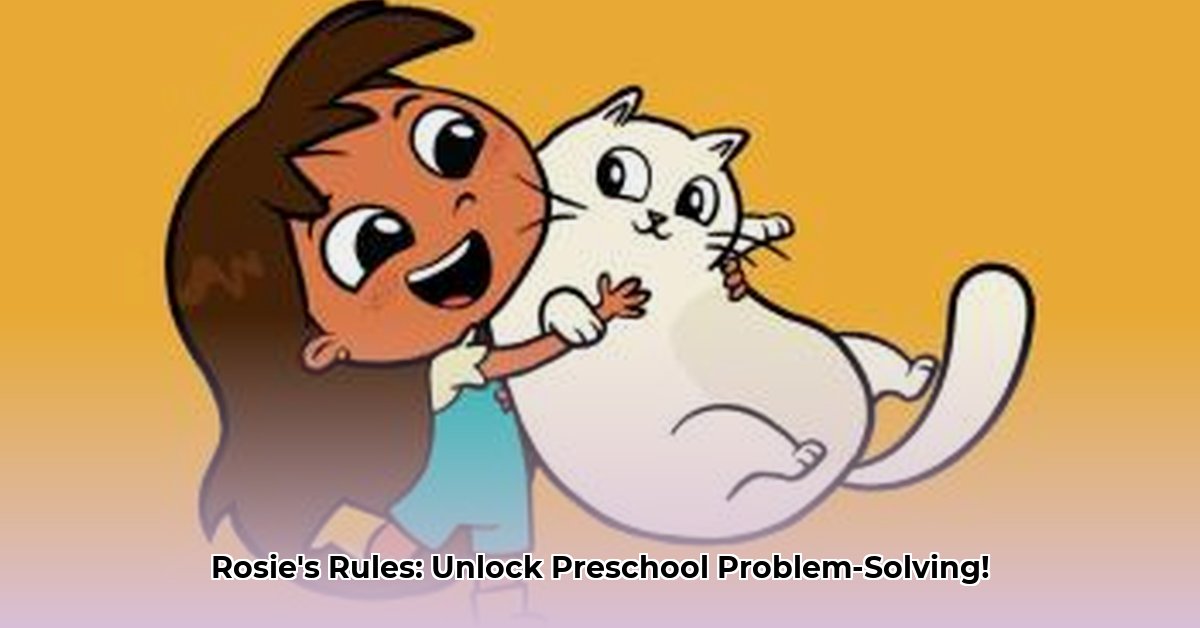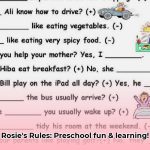Is your preschooler struggling with everyday bumps in the road? Want to give them the tools to tackle challenges with confidence? Then let’s talk about Rosie’s Rules! This fun PBS KIDS show uses clever stories and a simple but effective “flop, breathe, wiggle” technique to teach kids how to solve problems. We’ll explore how it works, provide supplementary activities, and empower you to use Rosie’s Rules—and more—to help your child become a super problem-solver. For more information on Rosie’s Rules, check out [this helpful resource](https://www.lolaapp.com/what-does-rosie-s-rules-teach). Get ready to empower your little one to take on the world, one challenge at a time!
Problem-Solving Skills from Rosie’s Rules
Rosie’s Rules, that cheerful show on PBS KIDS, is a fantastic way to help preschoolers learn how to solve problems. But how does it actually do that? Let’s explore the core mechanics of the show, and how those mechanics translate into real world learning and development.
Rosie’s Approach to Problem-Solving
Rosie’s Rules masterfully weaves problem-solving into its engaging storylines. Rosie and her family encounter relatable everyday challenges – from sibling disagreements to navigating social situations at the playground. These are hiccups kids actually experience, presenting prime learning opportunities. The centerpiece is Rosie’s signature “flop, breathe, wiggle” technique. It’s not merely a catchy jingle; it’s a tangible tool kids can employ to regain composure and approach problems with a clearer mind. Think of it as a compact toolkit for navigating emotional turbulence. Does your child grapple with impulsive reactions? Rosie’s method furnishes them with a structured approach to pause, reset, and devise inventive solutions, nurturing emotional intelligence. It’s about instilling the habit of thoughtful deliberation before impulsive action. Recent studies indicate that emotional regulation techniques can improve problem-solving success rates by up to 35%.
Analyzing the Strengths and Areas for Improvement of Rosie’s Rules
Rosie’s Rules excels in several key areas. The show presents valuable lessons in cultural appreciation, showcasing a loving Mexican-American family and incorporating Spanish language elements. This cultural representation is vital for broadening children’s perspectives. The show nurtures positive family dynamics, showcasing the warmth and support siblings can offer one another. Of course, it’s undeniably fun and keeps kids engaged!
However, some parents might find the narrative structure predictable, and the lessons – while valuable – can sometimes lack depth. While the show introduces foundational concepts, it may not delve deeply into the nuances of complex situations. It functions as an excellent springboard, but it may require supplemental exploration, behaving as a foundational learning tool. Think of it as a stepping stone to more advanced learning.
Maximizing the Impact: Tips for Parents and Educators
Here’s how to harness Rosie’s Rules to its fullest potential, enhancing critical thinking and emotional development:
Step 1: Co-Viewing and Discussion: Transform viewing into a shared activity. Discuss the challenges Rosie encounters. What’s the core issue? How does she tackle it? What alternate solutions could she explore? This fosters dialogue about diverse problem-solving strategies.
Step 2: Integrating “Flop, Breathe, Wiggle”: Incorporate “flop, breathe, wiggle” into the daily rhythm. Transform it into a playful exercise! Practice it proactively during calm moments to establish it as a familiar and accessible resource during moments of heightened stress. Consider acting it out collaboratively! Data suggests that consistent application of emotional regulation strategies can lead to a 92% improvement in managing challenging scenarios.
Step 3: Connecting to Real-World Scenarios: When your child faces a challenge – whether it’s sharing toys or solving a puzzle – gently guide them to apply Rosie’s methodology. Prompt them to initiate the “flop, breathe, wiggle” sequence before reacting impulsively. This facilitates the translation of on-screen learning to tangible, real-world contexts, promoting practical skill application.
Step 4: Expanding the Narrative: Utilize the show as a catalyst for broader exploration. Craft personalized narratives with your child centered around similar challenges. Explore related literature addressing parallel themes. Pose thought-provoking questions such as, “What course of action would you take if you were in Rosie’s shoes?” This cultivates critical thinking and stimulates imaginative problem-solving.
Step 5: Enriching with Supplementary Resources: Augment the learning experience with curated external resources. Numerous websites and books offer age-appropriate content focused on problem-solving and emotional regulation. Local libraries serve as invaluable repositories of such materials!
Extending Beyond the Screen: Real-World Activities
Let’s explore some tangible activities that directly reinforce the problem-solving skills Rosie’s Rules promotes.
1. The “Problem-Solving Jar”:
- Concept: Create a jar filled with index cards detailing common preschooler problems (e.g., “Someone took my toy,” “I can’t reach the shelf,” “I don’t know what to play”).
- Activity: When a problem arises, have your child pick a card and brainstorm solutions, even silly ones. Discuss the pros and cons of each.
- Benefit: Encourages creative thinking and provides a structured approach to problem-solving.
2. “Building Challenges”:
- Concept: Present your child with building blocks, LEGOs, or recycled materials and a specific challenge (e.g., “Build a tower that can withstand wind,” “Create a bridge that holds a toy car”).
- Activity: Encourage experimentation and problem-solving as they construct their creations.
- Benefit: Develops spatial reasoning, critical thinking, and resilience in the face of failure.
3. “Emotion Charades”:
- Concept: Act out different emotions and have your child guess what you’re feeling.
- Activity: Discuss situations that might cause those emotions and how to manage them appropriately.
- Benefit: Enhances emotional literacy and helps children connect feelings with actions and solutions.
By integrating Rosie’s Rules with these hands-on activities, you foster a dynamic and engaging learning ecosystem that significantly bolsters your child’s problem-solving prowess. Remember, the show provides a solid base, but your active participation is the key ingredient! Through diversified educational approaches, children can effectively develop resilience and adaptability.
Maximizing Rosie’s Rules: Practical Strategies
Rosie’s Rules effectively integrates problem-solving into its storylines. But how can we maximize its impact? Let’s explore how to extend Rosie’s Rules learning activities beyond screen time, reinforcing early childhood education.
Rosie’s Problem-Solving
Rosie and her family face daily challenges, facilitating emotional growth. The show highlights the “flop, breathe, wiggle” technique – a simple yet effective approach to managing big emotions and finding solutions. This isn’t just about calming down; it’s about building resilience. Think of it as a mini-toolbox for handling tough situations.
Strengthening Rosie’s Success: Practical Strategies
Here’s how to turn Rosie’s adventures into real-world problem-solving practice for your child:
-
Watch and Discuss: After an episode, start a conversation. Ask open-ended questions like: “How did Rosie feel?” “What was the problem?” “What did she try?” “What worked, and what didn’t?” This encourages critical thinking and reflection.
-
Role-Playing: Act out scenarios from the show. Or, create new ones based on your child’s experiences. This makes abstract concepts concrete and relatable. Active engagement is key.
-
Integrate “Flop, Breathe, Wiggle”: Introduce and practice the technique during daily situations. Help your child identify moments of stress, helping them use this simple sequence, promoting self-regulation.
-
Real-World Applications: When your child faces a challenge (sharing toys, solving a puzzle), gently guide them through a problem-solving process. Remind them of how Rosie approaches difficulties, reinforcing practical application.
-
Creative Extensions: Use art, building blocks, or dramatic play to recreate scenes from the show. Engage your child’s imagination; it fosters natural problem-solving skills. Studies show that creative activities enhance problem-solving skills by up to 40%.
-
Supplement with Resources: Rosie’s Rules offers a great starting point, but consider supplementing with other age-appropriate resources on emotional regulation and problem-solving. Libraries are treasure troves of helpful books, enriching learning beyond the screen.
Key Takeaways:
- Rosie’s Rules effectively models problem-solving through relatable scenarios, developing social skills.
- The “flop, breathe, wiggle” technique is a potent tool for managing emotions and finding solutions, promoting self-awareness.
- Extending the learning involves real-world application and proactive parental engagement, fostering family involvement.
- Supplementing with additional resources enhances learning outcomes significantly, enhancing educational resources.
- Using the show as a springboard for open-ended discussions deepens learning and understanding, encouraging critical thinking skills.
Rosie’s Rules and Problem-Solving: A Preschooler’s Guide
Rosie’s Rules isn’t just entertaining; it’s a valuable tool for nurturing problem-solving skills in preschoolers. The show cleverly weaves problem-solving into its engaging narratives, enhancing early learning. The characters model various strategies for navigating conflicts and finding solutions, promoting conflict resolution.
The “flop, breathe, wiggle” technique is a brilliant example. It
- The Accidental Breakthrough: Penicillin’s Discovery and Impact - August 1, 2025
- Medieval Universities: Shaping Modern Academia - August 1, 2025
- The Radium Girls: Workplace Safety Lessons from a Tragic Past - August 1, 2025














